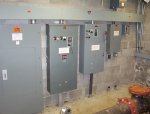In all the jobs I did over 38 years, I would always use wireway, usually across the top of the equipment and rigid nipples down into the panels. The top of the panels, starters were all set at 5-6" AFF and the wireway was usually 6 -0 AFF to the top. For the control panels we put a wireway across the bottom and nippled up to the top wireway. And with wireway you don't have to derate until you get to 30 conductors.
One job was a 300 amp 480 volt service, I had a 12" x 12' x 12 ft wire way made at a enclosure shop (Charlie-Skyline Electric in Seattle) nippled down to an I line panel, size 3 starter, size 4 starter, lighting xfmr and lighting panel. The building was wired in EMT.
For a small 20 x 25 ft water treatment building, we ran 6x6 wire way near the top all the way around. Nippled down to gear, looked great and saved time. I will try and post pictures later. You can put a divider in the WW if required.
the wireway has the flexiblity of cable tray, but its more along the lines of what most electricians have worked with. I would suggest a good elevation drawing.



